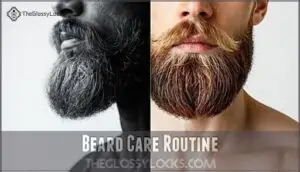This site is supported by our readers. We may earn a commission, at no cost to you, if you purchase through links.
 If your beard is too stiff, how to soften it effectively starts with proper washing using lukewarm water and beard-specific shampoo.
If your beard is too stiff, how to soften it effectively starts with proper washing using lukewarm water and beard-specific shampoo.
Skip harsh chemicals that strip natural oils. Apply quality beard oil immediately after showering while hair’s still damp – jojoba and argan oils work wonders.
Use a leave-in conditioner for extra moisture, and don’t forget regular trimming to remove split ends that make beards feel coarse.
Daily brushing distributes oils evenly, while beard balm adds hold and hydration. The secret isn’t just one product – it’s combining the right techniques with consistent care that transforms even the scratchiest whiskers into touchably soft facial hair.
Combining the right techniques with consistent care is key to achieving soft facial hair.
Table Of Contents
- Key Takeaways
- Soften Stiff Beard Naturally
- Beard Washing Techniques
- Beard Oil and Moisturizing
- Conditioning for Soft Beard
- Trimming and Maintenance
- Beard Care Routine
- Frequently Asked Questions (FAQs)
- How to soften a stiff beard?
- Can I relax my beard to make it soft?
- How to get a wiry beard to lay flat?
- Why is my beard hair so stiff?
- How often should I trim my beard?
- What causes beard hair to become stiff?
- Can diet affect beard softness and texture?
- Should I use heat when styling beards?
- How long does beard softening take?
- Conclusion
Key Takeaways
- Wash smart: Use beard-specific shampoo 2-3 times weekly with lukewarm water to preserve natural oils, then follow with a pH-balanced conditioner to prevent that wire-brush texture.
- Oil immediately after showering: Apply quality beard oil (jojoba or argan) to damp hair for maximum absorption – this locks in moisture and transforms coarse whiskers into touchable softness.
- Trim regularly: Cut split ends every 2-3 weeks with sharp scissors or trimmers to prevent damage that makes your beard feel rough and unmanageable.
- Build a daily routine: Combine beard oil, leave-in conditioner, and regular brushing to distribute natural oils evenly – consistency is what transforms stubborn facial hair into silk-smooth perfection.
Soften Stiff Beard Naturally
A stiff beard feels like sandpaper and can irritate your skin and your partner’s face during close contact.
The good news is that you can transform your rough facial hair into a soft, manageable beard using natural methods that work with your hair’s structure rather than against it.
Wash and Condition Regularly
Regular beard washing and conditioning transforms your stiff facial hair into a soft, manageable mane.
Your beard needs consistent care to maintain proper hydration and texture.
A stiff beard demands daily attention—skip the routine and face the consequences.
Here’s your beard softening routine:
- Wash frequency: Cleanse 2-3 times weekly to prevent over-drying
- Water temperature: Use lukewarm water to preserve natural oils
- Product application: Apply beard conditioner immediately after washing
- Beard hydration: Follow with moisturizing treatments while damp
- Conditioner types: Choose pH-balanced formulas for superior results
This simple beard care approach prevents stiffness while keeping your whiskers healthy and touchable.
Use Beard Specific Shampoos
Anyone can transform their stiff beard into something softer by switching to beard-specific shampoos. These products contain gentle shampoo ingredients that won’t strip natural oils like regular soap does.
Look for sulfate alternatives with balanced product pH levels. A key ingredient to look for is jojoba oil, which mimics the skin’s natural oils.
When washing frequency hits 2-3 times weekly, your beard softening routine becomes more effective. Even stubble washing benefits from dedicated beard shampoo designed for proper beard care with quality beard products.
Avoid Harsh Chemicals and Sulfates
Your beard’s chemistry matters more than you think.
Sulfates strip natural oils that keep facial hair soft, while harsh chemicals can trigger beard stiffness and skin irritation.
Here’s what to avoid for a softer beard:
- Skip sulfate-heavy shampoos – Look for sulfate alternatives like cocamidopropyl betaine on product labels
- Choose natural ingredients – Opt for DIY beardcare with jojoba or argan beard oil over synthetic formulas
- Read ingredient lists – Avoid parabens and alcohols that worsen chemical sensitivities and prevent proper beard softening
Beard Washing Techniques
Your beard washing technique makes all the difference between a scratchy mess and silky smooth facial hair.
The right water temperature and proper product application will transform your stiff beard into something your partner actually wants to touch, which can significantly improve your overall beard experience.
Use Lukewarm Water for Cleansing
Hot water strips your beard’s natural oils, leaving it dry and brittle.
Hot water is your beard’s worst enemy – it strips away the natural oils that keep your whiskers soft and touchable.
Lukewarm water protects these Oil Preservation elements while opening hair cuticles for Enhanced Absorption of products.
This Ideal Temperature maintains Cuticle Health and Prevents Dryness, making beard softening more effective than harsh stiff beard treatments.
| Water Temperature | Effect on Beard |
|---|---|
| Hot Water | Strips natural oils, causes dryness |
| Lukewarm Water | Preserves oils, opens cuticles gently |
| Cold Water | Seals cuticles, limited cleaning power |
Apply Shampoo and Conditioner Correctly
Mastering your application technique transforms even the coarsest whiskers into silk.
Start with a quarter-sized amount of beard shampoo, working it through damp facial hair using circular motions. Follow with conditioner, focusing on mid-lengths and ends where stiffness lurks.
- Work shampoo into roots first – this removes buildup while protecting hair cuticles from damage
- Apply conditioner from mid-beard down – avoiding roots prevents greasiness while targeting dry, coarse areas
- Massage for 30 seconds minimum – proper application technique guarantees product ingredients penetrate hair shafts for maximum beard softness
Rinse Thoroughly to Prevent Buildup
After applying beard conditioner correctly, you’ll want to rinse everything out completely.
Poor rinsing leads to product accumulation that makes your beard feel stiff and grimy.
Use lukewarm water temperature for ideal residue removal—hot water strips natural oils while cold water doesn’t cleanse effectively.
Spend at least 30 seconds rinsing to prevent buildup.
Using a quality beard wash can also prevent residue.
This simple step dramatically improves beard softness and maintains healthy beard care habits.
Beard Oil and Moisturizing
You’ll need the right beard oil to transform your stiff facial hair into something soft and manageable.
Proper application timing and choosing oils with the right properties makes all the difference in achieving that smooth, touchable beard you want.
Choose Right Beard Oil for Skin Type
Your skin type determines which beard oil will work best to soften your stiff facial hair.
Oily Skin needs lightweight options like grapeseed oil, while Dry Skin benefits from heavier argan or jojoba oils. Sensitive Skin requires fragrance-free formulas to avoid irritation.
Selecting the right oil guarantees maximum nourishment and hydration.
- Acne Prone – Choose non-comedogenic oils like hempseed
- Combination Skin – Use balanced apricot kernel oil
- Dry Beard – Apply vitamin E-rich formulas for deep moisturizing
Apply Oil Immediately After Shower
Your beard soaks up oil like a sponge when it’s damp.
Apply beard oil immediately after showering while your facial hair retains moisture – this timing maximizes oil absorption rate and creates powerful skin hydration synergy.
The damp hair benefits include enhanced product application timing, boosting your beard’s softness enhancement frequency for ideal texture transformation, which leads to a powerful skin hydration synergy.
Use Jojoba and Argan Oils for Hydration
When your timing’s right, choosing the best oils makes all the difference.
Jojoba oil mimics your skin’s natural sebum, providing lightweight hydration that penetrates deeply. Argan oil’s essential fatty acids lock in moisture while preventing frizz.
- Jojoba Oil Benefits: Non-comedogenic formula won’t clog pores while strengthening hair follicles
- Argan Oil Benefits: Anti-inflammatory properties soothe irritation and add natural shine
- Oil Application Tips: Apply to damp beard for maximum absorption and even distribution
Conditioning for Soft Beard
You’ll want to condition your beard after every wash to counteract the harsh effects of water and cleansing products.
A good pH-balanced conditioner strengthens hair strands and makes your beard feel softer and more manageable than a porcupine’s back, with a notable improvement in how it feels, thanks to being more manageable.
Use PH Balanced Conditioners
Most conditioners work against your skin’s natural pH balance, leaving your coarse beard feeling like sandpaper.
pH-balanced conditioners match your skin’s 5.5 acidity level, creating the perfect environment for beard softening.
These specialized formulas flatten hair cuticles, reducing breakage and improving texture for lasting smoothness.
| pH Importance | Conditioner Ingredients | Hair Strength Benefits |
|---|---|---|
| Matches skin’s natural 5.5 pH | Glycerin for moisture retention | Reduces breakage by 40% |
| Prevents irritation and redness | Shea butter for cuticle protection | Strengthens hair follicles |
| Maintains healthy skin barrier | Coconut oil for deep hydration | Improves elasticity |
| Reduces beardruff and flaking | Natural oils seal moisture | Prevents split ends |
Leave-in Conditioners for Dry Beards
When your beard feels like sandpaper, leave-in conditioners become your best friend.
These lightweight formulas don’t need rinsing, making them perfect for daily application frequency on a dry beard. Look for ingredients like shea butter and glycerin – best ingredients that penetrate coarse beard hair without weighing it down.
You can create homemade recipes using coconut oil and aloe vera for an overnight treatment that’ll moisturize your beard while you sleep. Some conditioners contain nourishing herbal extracts to soothe irritated skin.
Regular Conditioning for Manageable Beard
Building on leave-in treatments, establishing a consistent conditioning routine transforms your coarse beard into manageable perfection.
You’ll want to condition regularly—not sporadically—to maintain that soft, touchable texture your partner loves.
Conditioner Ingredients matter more than frequency.
- Protein-rich formulas with keratin rebuild damaged hair cuticles naturally
- Moisturizing agents like glycerin and panthenol penetrate deep into follicles
- Natural oils including argan and jojoba that don’t clog pores
- pH-balanced solutions that strengthen hair strands without harsh chemicals
- DIY Conditioners using coconut oil and honey for budget-friendly deep conditioning
Application Frequency depends on your beard’s needs. Dry, brittle beards benefit from daily conditioning, while oily types need it 2-3 times weekly. Deep Conditioning treatments once weekly provide intensive repair for severely damaged facial hair.
The Leave-in Benefits compound when you’re consistent. Your beard grooming routine becomes effortless when you moisturize beard properly. This systematic approach to soften beard hair eliminates morning battles with stubborn whiskers.
Trimming and Maintenance
You can’t fix a stiff beard without addressing the root cause – damaged ends that make everything feel coarse and unruly.
Regular trimming isn’t just about looks; it’s your secret weapon for transforming that bristly mess into something actually pleasant to touch, by tackling the damaged ends.
Trim Beard to Remove Split Ends
Split ends turn your beard into a scratchy mess that’ll make anyone want to run the other direction.
Regular trimming every 2-3 weeks removes these damaged ends, instantly improving softness and appearance.
Here’s when and why to trim:
| Split End Causes | Trimming Frequency | Benefits |
|---|---|---|
| Cold weather exposure | Every 2-3 weeks | Maintains beard shape |
| Overuse of products | Monthly for shorter beards | Prevents further damage |
| Heat damage from styling | Bi-weekly for longer beards | Improves texture |
| Natural wear and tear | As needed for problem areas | Enhances beard grooming |
Professional trimming guarantees you maintain beard shape while removing damaged ends.
Addressing improper beard care is vital to preventing these split ends from recurring.
Combined with beard oil and beard balm, regular trimming creates the foundation for a softer, more manageable beard that actually feels good to touch.
Use Quality Beard Scissors and Trimmers
When choosing beard scissors and trimmers, sharp blades make all the difference.
Dull tools create ragged cuts that actually increase split ends, making your beard feel rougher.
Invest in quality beard scissors with precision-ground edges and a powerful trimmer that won’t tug or pull.
Consider exploring options for top-rated beard trimmers for superior grooming.
Good scissor quality guarantees clean cuts that prevent damage, while proper trimming technique keeps your beard looking sharp and feeling softer.
Regular Trimming for Neat Appearance
Every two weeks, give your beard a maintenance trim to keep it looking sharp and feeling soft.
Regular trimming removes split ends that make your beard appear dull and feel scratchy.
Use quality scissors or trimmers with sharp blades – dull tools create more split ends than they fix.
Focus on trimming techniques that maintain your desired beard shape while promoting better manageability.
Beard Care Routine
A solid beard care routine transforms your stiff, unruly facial hair into the smooth, manageable beard you’ve always wanted.
Think of it as your daily insurance policy against the dreaded "wire brush" look that makes your partner dodge your morning kiss, which can be prevented with a good beard care routine that keeps your beard smooth and manageable.
Daily Combing and Brushing for Softness
Through consistent combing and brushing, you’ll distribute natural oils from root to tip while aligning hair fibers for maximum softness.
Choose a quality boar bristle brush or wooden comb – the comb material matters for gentle detangling.
Your brushing technique should follow hair growth direction, promoting sebum stimulation that naturally conditions your beard.
This oil distribution process transforms beard texture, helping you tame beard and manage beard effectively with these essential beard softening tips.
Apply Beard Balm for Hold and Moisture
The magic of beard balm lies in its dual-action formula.
Apply a pea-sized amount after oiling, working it through your beard to lock in moisture while providing gentle hold.
This balm vs. oil comparison shows balm’s superior staying power—it creates a protective barrier that tames beard flyaways for hours.
Many balms include natural oils for moisture and beard health.
Focus on balm application tips: warm it between palms first, then distribute evenly from roots to tips for maximum balm hold strength.
Avoid Polyunsaturated Oils for Beard Health
Understanding the science behind beard oil ingredients can save you from sabotaging your beard goals.
PUFA oils create lipid peroxidation risks that damage hair follicles, while rancid oil concerns make your beard brittle instead of soft.
Here’s what hurts your beard health:
- Hemp seed and grapeseed oils – high PUFA content blocks DHT production
- Canola and sunflower oils – oxidize quickly, causing inflammation
- Almond oil blends – go rancid fast, creating free radicals
- Cheap commercial blends – often hide unstable polyunsaturated fats
Choose monounsaturated alternatives like jojoba or argan oil instead.
These natural oils offer oil stability factors that support beard softening without hormonal disruption.
Saturated fat benefits include better penetration and longer shelf life, making your beard routine more effective.
Frequently Asked Questions (FAQs)
How to soften a stiff beard?
Like finding the perfect beard day, you’ll need daily beard oil, weekly conditioning, and lukewarm water washing. Skip regular shampoo—it strips natural oils, making hair coarse and unmanageable permanently.
Can I relax my beard to make it soft?
You can’t chemically "relax" your beard like hair, but you can definitely soften it.
Use beard oil daily, wash with beard-specific shampoo, and condition regularly to transform that wire brush into something smooth.
How to get a wiry beard to lay flat?
Use beard oil daily after washing, apply beard balm for hold, brush regularly to train hairs downward, and trim split ends that cause wiry texture.
Why is my beard hair so stiff?
Your beard feels stiff because it’s lacking moisture and natural oils.
Washing too frequently, using harsh shampoos, or skipping conditioning strips away sebum.
Cold weather and poor grooming habits also contribute to this wiry, coarse texture.
How often should I trim my beard?
Trimming frequency depends on your beard goals.
For maintaining length, trim every 2-3 weeks to remove split ends and keep things tidy.
Growing it out? Trim monthly to prevent damage while preserving progress.
What causes beard hair to become stiff?
Like a parched garden needs water, your beard becomes stiff when it’s stripped of natural oils through overwashing, harsh products, or environmental factors like cold weather and heat damage.
Can diet affect beard softness and texture?
Your diet absolutely impacts beard texture.
Protein, healthy fats, and vitamins A, C, and E nourish hair follicles from within.
Dehydration makes hair brittle, while proper nutrition creates softer, more manageable facial hair naturally, and vitamins are essential for this process.
Should I use heat when styling beards?
Play it cool when styling your beard – excessive heat can damage hair and cause split ends.
Use low heat settings sparingly, and always apply a heat protectant first to prevent dryness.
How long does beard softening take?
Beard softening happens gradually, with noticeable improvements in 1-2 weeks of consistent care.
Daily beard oil application shows results within days, while proper washing and conditioning routines deliver maximum softness after 2-3 weeks of regular use.
Conclusion
Transforming your beard from wire-brush rough to silk-smooth doesn’t happen overnight, but consistency pays off.
Whether you’re dealing with stubborn coarse hair or new growth that feels like sandpaper, these proven methods work when you stick with them.
Remember, if your beard is too stiff and softening becomes your daily concern, combining proper washing techniques with quality oils and regular conditioning creates the foundation for success.
Your patience and dedication will reward you with a beard that’s softer and healthier too.
- https://www.verygoodlight.com/
- https://en.wikipedia.org/wiki/Lipid_peroxidation
- https://www.ncbi.nlm.nih.gov/pmc/articles/PMC5464545/
- https://www.fda.gov/cosmetics/cosmetics-laws-regulations/prohibited-restricted-ingredients-cosmetics
- https://www.zeusbeard.com/blogs/zeus-beard-blog/why-you-shouldnt-use-regular-hair-shampoo-and-conditioner-on-your-beard












